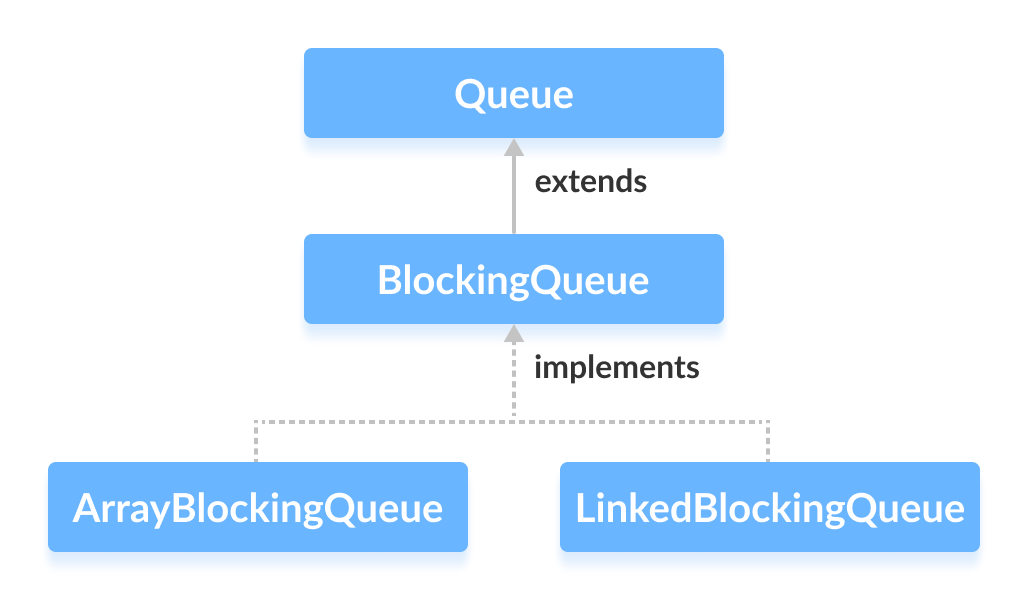Java Collections框架的LinkedBlockingQueue类使用链接列表提供阻止队列的实现。
它实现了Java BlockingQueue接口。

创建LinkedBlockingQueue
为了创建链接的阻塞队列,我们必须导入java.util.concurrent.LinkedBlockingQueue包。
这是我们如何在Java中创建链接的阻塞队列的方法:
1.无初始容量
LinkedBlockingQueue animal = new LinkedBlockingQueue<>();
在此,默认初始容量为2 31 -1。
2.具有初始容量
LinkedBlockingQueue animal = new LinkedBlockingQueue<>(int capacity);
这里,
- Type-链接的阻塞队列的类型
- 容量 -链接的阻塞队列的大小
例如,
// Creating String type LinkedBlockingQueue with size 5
LinkedBlockingQueue animals = new LinkedBlockingQueue<>(5);
// Creating Integer type LinkedBlockingQueue with size 5
LinkedBlockingQueue age = new LinkedBlockingQueue<>(5);
注意:不必提供链接列表的大小。
LinkedBlockingQueue的方法
LinkedBlockingQueue类提供BlockingQueue接口中所有方法的实现。
这些方法用于从链接的阻塞队列中插入,访问和删除元素。
此外,我们还将学习支持链接的阻塞队列中的阻塞操作的两种方法put()和take() 。
这两种方法将链接的阻塞队列与其他典型队列区分开来。
插入元素
-
add()-将指定的元素插入链接的阻塞队列。如果队列已满,它将引发异常。 -
offer()-将指定的元素插入到链接的阻止队列中。如果队列已满,则返回false。
例如,
import java.util.concurrent.LinkedBlockingQueue;
class Main {
public static void main(String[] args) {
LinkedBlockingQueue animals = new LinkedBlockingQueue<>(5);
// Using add()
animals.add("Dog");
animals.add("Cat");
// Using offer()
animals.offer("Horse");
System.out.println("LinkedBlockingQueue: " + animals);
}
}
输出
LinkedBlockingQueue: [Dog, Cat, Horse]
访问元素
-
peek()-从链接的阻塞队列的前面返回一个元素。如果队列为空,则返回null。 -
iterator()-返回一个迭代器对象,以按顺序访问链接的阻塞队列中的元素。如果队列为空,则抛出异常。我们必须导入java.util.Iterator包才能使用它。
例如,
import java.util.concurrent.LinkedBlockingQueue;
import java.util.Iterator;
class Main {
public static void main(String[] args) {
LinkedBlockingQueue animals = new LinkedBlockingQueue<>(5);
// Add elements
animals.add("Dog");
animals.add("Cat");
animals.add("Horse");
System.out.println("LinkedBlockingQueue: " + animals);
// Using peek()
String element = animals.peek();
System.out.println("Accessed Element: " + element);
// Using iterator()
Iterator iterate = animals.iterator();
System.out.print("LinkedBlockingQueue Elements: ");
while(iterate.hasNext()) {
System.out.print(iterate.next());
System.out.print(", ");
}
}
}
输出
LinkedBlockingQueue: [Dog, Cat, Horse]
Accessed Element: Dog
LinkedBlockingQueue Elements: Dog, Cat, Horse,
删除元素
-
remove()-从链接的阻塞队列中返回并删除指定的元素。如果队列为空,则抛出异常。 -
poll()-返回指定的元素并将其从链接的阻塞队列中移除。如果队列为空,则返回null。 -
clear()-从链接的阻止队列中删除所有元素。
例如,
import java.util.concurrent.LinkedBlockingQueue;
class Main {
public static void main(String[] args) {
LinkedBlockingQueue animals = new LinkedBlockingQueue<>(5);
animals.add("Dog");
animals.add("Cat");
animals.add("Horse");
System.out.println("LinkedBlockingQueue " + animals);
// Using remove()
String element1 = animals.remove();
System.out.println("Removed Element:");
System.out.println("Using remove(): " + element1);
// Using poll()
String element2 = animals.poll();
System.out.println("Using poll(): " + element2);
// Using clear()
animals.clear();
System.out.println("Updated LinkedBlockingQueue " + animals);
}
}
输出
LinkedBlockingQueue: [Dog, Cat, Horse]
Removed Elements:
Using remove(): Dog
Using poll(): Cat
Updated LinkedBlockingQueue: []
put()和take()方法
在多线程处理中,我们可以使用put()和take()阻止一个线程的操作,以使其与另一个线程同步。这些方法将等待,直到可以成功执行。
put()方法
要将指定的元素插入到链接的阻塞队列的末尾,我们使用put()方法。
如果链接的阻塞队列已满,它将等待,直到链接的阻塞队列中有足够的空间来插入元素。
例如,
import java.util.concurrent.LinkedBlockingQueue;
class Main {
public static void main(String[] args) {
LinkedBlockingQueue animals = new LinkedBlockingQueue<>(5);
try {
// Add elements to animals
animals.put("Dog");
animals.put("Cat");
System.out.println("LinkedBlockingQueue: " + animals);
}
catch(Exception e) {
System.out.println(e);
}
}
}
输出
LinkedBlockingQueue: [Dog, Cat]
在这里,如果put()方法在等待时被中断,则可能会抛出InterruptedException 。因此,我们必须将其包含在try..catch块中。
take()方法
要从链接的阻塞队列的前面返回并删除一个元素,可以使用take()方法。
如果链接阻止队列为空,它将等待,直到链接阻止队列中有要删除的元素。
例如,
import java.util.concurrent.LinkedBlockingQueue;
class Main {
public static void main(String[] args) {
LinkedBlockingQueue animals = new LinkedBlockingQueue<>(5);
try {
//Add elements to animals
animals.put("Dog");
animals.put("Cat");
System.out.println("LinkedBlockingQueue: " + animals);
// Remove an element
String element = animals.take();
System.out.println("Removed Element: " + element);
System.out.println("New LinkedBlockingQueue: " + animals);
}
catch(Exception e) {
System.out.println(e);
}
}
}
输出
LinkedBlockingQueue: [Dog, Cat]
Removed Element: Dog
New LinkedBlockingQueue: [Cat]
在这里,如果take()方法在等待时被中断,则会抛出InterrupedException 。因此,我们必须将其包含在try...catch块中。
其他方法
| Methods | Descriptions |
|---|---|
contains(element) |
Searches the linked blocking queue for the specified element. If the element is found, it returns true, if not it returns false. |
size() |
Returns the length of the linked blocking queue. |
toArray() |
Converts linked blocking queue to an array and return the array. |
toString() |
Converts the linked blocking queue to string |
为什么要使用LinkedBlockingQueue?
LinkedBlockingQueue使用链接列表作为其内部存储。
它被认为是线程安全的集合。因此,它通常用于多线程应用程序中。
假设一个线程正在将元素插入队列,而另一个线程正在从队列中删除元素。
现在,如果第一个线程比第二个线程慢,则链接的阻塞队列可使第二个线程等待,直到第一个线程完成其操作。